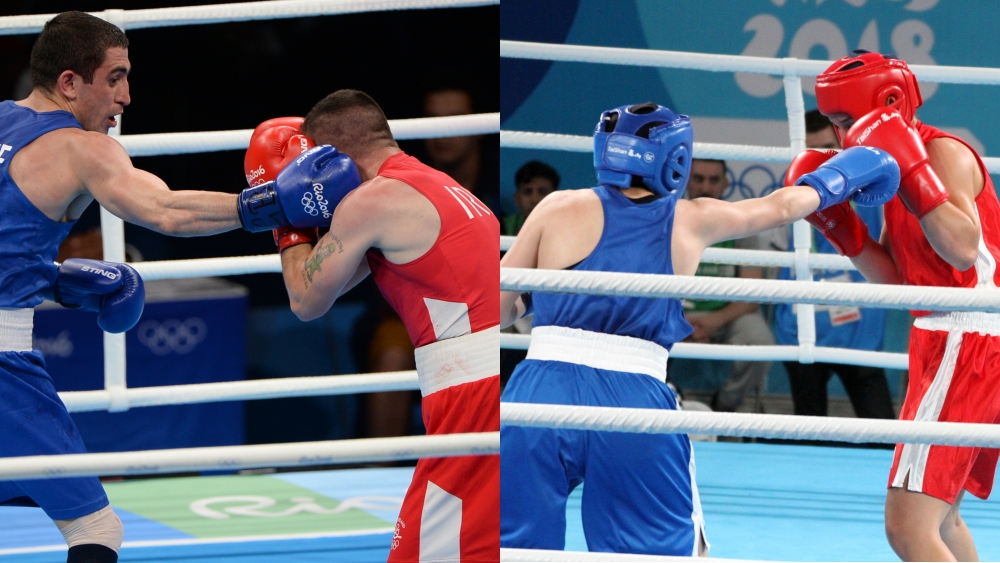
The fundamental goal of boxing is to hit your opponent without getting hit. Some boxers will tell you that being offensive is the best defense, but that’s not true. Throwing a punch creates openings for your opponent to land counters on you. Watch several boxing highlight reels, and it becomes clear that most knockouts occur while the fighter who was knocked out is throwing a punch.
The best defense is taking the time to master the fundamentals of boxing defense. There’s a reason why some of the best boxers ever are counterpunchers. Fighters like Floyd Mayweather used their virtually impenetrable defense to keep them safe while landing hard counters whenever they saw openings.
The four most used types of blocks in boxing include:
- High Guard: This is often the first guard boxers learn.
- The Lead Hand Guard: This involves raising your lead elbow so it’s pointing at your opponent. It’s great for blocking hooks.
- The Rear Hand Guard: This is the same as the lead hand guard but on the opposite side.
- Low Block: This involves keeping your elbows close to your torso to block body shots.
Mastering The Art Of Blocking And Catching In Boxing
The best defense in boxing is typically to avoid the punch with your footwork or head movement, but that isn’t always possible. Blocking is typically a last resort when you can’t get away from an opponent’s punch while catching a punch is often used to stop punches before they get to your face.
Let’s take a detailed look at the correct way to block and catch punches inside the boxing ring:
1) Blocking Hooks
While evading punches allows you to avoid taking any damage, it also uses up more energy than blocking. Blocking refers to taking a punch on the less vulnerable parts of your body, like your shoulders, gloves, elbows, and arms. The goal of blocking is to avoid absorbing the impact in more vulnerable parts of your body like the liver area, head, temple, or face.
The jab and cross are typically the most challenging to block since they are thrown right in the middle of your guard. That’s one of the reasons why crosses can be so effective in boxing since it comes right down the middle and carries a lot more power than a jab. Looping punches are a bit easier to block since most boxers keep their guard at the side of their head, so their arms are already in the position to block.
Blocking Rear Hooks
Hooks are the most used power punches in boxing and they can land with considerable force when executed properly. Properly blocking in boxing requires you to always keep your hands up and high. However, that’s not enough to stop hooks since your temples and the top of your head remain exposed when throwing hooks.
Here are the proper mechanics for blocking hooks:
- Raise your blocking hand higher than your normal guard to ensure your entire head is protected.
- Make sure your elbow forms a 90-degree angle with your body and move the arm toward the center of your face.
- Lean your head to the opposite side as the punch comes toward you.
A rear hook can be tricky to duck under if your opponent throws it with good technique without any load-up. Blocking becomes your best defensive option at that point. That doesn’t mean you should only block in these situations. There’s nothing wrong with blocking while trying to step out of harm’s way or weaving under a punch.
Blocking A Lead Hook
A lead hook is often trickier to evade than a rear hook since it covers less distance to reach you. This makes learning how to block a lead hook more vital since it takes a lot of experience to see it and get out of its way.
Blocking a lead hook involves the same mechanics as blocking a rear hook. It’s just done on the opposite side.
Blocking Hooks To Your Body
Blocking hooks to your body requires you to drop your guard and bring your elbow toward your hips so your entire rib cage area is protected. Bend your back a bit toward the direction the punch is coming from to bring your arms lower, but remember to keep your chin tucked while protecting your face with your fists.
2) Blocking The Cross
Your first line of defense against the cross is your head movement since simply moving your head off the centerline is typically enough to evade it. When slipping past the punch isn’t an option, it’s time to use your guard to protect the vulnerable parts of your body.
The goal is to get the cross to glide across your elbow, glove, and forearm by rotating your elbow while you have your guard up. This steers the power behind the punch away so you don’t absorb it on your body. Don’t rotate enough, and your chin will end up exposed. Rotate too much, and the side of your face might be left vulnerable.
3) Blocking Uppercuts
Blocking an uppercut isn’t much different from blocking a hook. The main difference is that you rotate your torso and move your blocking arm slightly so the uppercut lands on your elbow or forearm.
You want to bring the elbow of your lead hand to the centerline so your chin is protected from the strike.
Catching Punches
Catching and parrying punches are often confused with each other, but there are slight differences. Parrying involves deflecting an incoming punch by hitting your opponent’s hand while catching involves using your open palm to stop a punch.
Both are high-risk defensive techniques, so you want to get the basics of blocking down before moving on to these advanced defensive techniques.
Catches are typically reserved for straight punches in boxing and the main goal is to provide just enough resistance to avoid getting your hand pushed back into your face.
Here’s how the technique works:
- From your fighting stance, raise your lead hand with your palm facing your opponent.
- Imagine you’re trying to catch a baseball with a catcher’s mitt. It’s very similar to what you’re trying to do here.
- Move your head so it’s behind your outstretched hand. Look to counter once you’ve absorbed the force of the incoming punch.
You may also like:
The Impact Of Boxing On Youth Development In Singapore
At its core, boxing is a simple sport where participants aim to land more punches than their opponents in hopes of eventually securing a knockout blow or winning the bout via decision. Casual observers often…
Boxing is perhaps the purest form of combat known to man. Nothing could be simpler than duking it out with nothing but the hands. Despite its inherent simplicity, there are several different styles and tactics…
There are a myriad of fighting styles in boxing, from the evasive Philly Shell style Floyd Mayweather uses to the aggressive Peekaboo style of Mike Tyson. Regardless of their individual style, skilled boxers share one…
Boxing is one of the most globalized combat sports, and the top boxers remain some of the highest-paid athletes in the world. Anyone can master the sweet science and enjoy the many rewards that come…
BJJ is often called “human chess” because it works the body and mind simultaneously. This fact is highlighted as you become more experienced and start facing better opponents, and you start seeing more of the…
The Peekaboo style of boxing is one that is unique in its concepts and execution in the ring. It was first developed by Constantine “Cus” D’amato, trainer to the legendary Mike Tyson. Focusing on a…
An increasing number of young athletes are choosing to make mixed martial arts their primary sport as it continues to gain global mainstream recognition. Being an MMA fighter is a lot cooler, safer, and appealing…
Muay Thai is a sport that allows fighters to punch, kick, knee, and elbow each other to their heart’s content for up to five rounds, many of whom refuse to back down even after facing…
The Lion City is a bustling metropolis and in it, lies a vibrant sporting community, with boxing increasingly gaining prominence among its youth. This interest is not unfounded, as boxing in Singapore offers a unique…
In Muay Thai, there are very few techniques that score higher than one where you dump your opponent down onto the canvas from the clinch. A dump hits almost all of the critical scoring criteria…
Strength training has become more popular in the past couple of decades as many old myths about what it does to your body have been debunked thanks to an improved understanding of how the body…
Finally, the school holidays are around the corner! Busy parents, don’t tear your hair out if your children are at home. There are more ways to keep them entertained besides Netflix’s selection of children’s TV…


![Virat Kohli will be my favourite wicket to get in the IPL: LSG's latest recruit Naman Tiwari [Exclusive]](https://babu88sports.com/wp-content/uploads/2025/12/virat-kohli-will-be-my-favourite-wicket-to-get-in-the-ipl-lsgs-latest-recruit-naman-tiwari-exclusive-360x180.png)






























![Virat Kohli will be my favourite wicket to get in the IPL: LSG's latest recruit Naman Tiwari [Exclusive]](https://babu88sports.com/wp-content/uploads/2025/12/virat-kohli-will-be-my-favourite-wicket-to-get-in-the-ipl-lsgs-latest-recruit-naman-tiwari-exclusive-120x86.png)



![Virat Kohli will be my favourite wicket to get in the IPL: LSG's latest recruit Naman Tiwari [Exclusive]](https://babu88sports.com/wp-content/uploads/2025/12/virat-kohli-will-be-my-favourite-wicket-to-get-in-the-ipl-lsgs-latest-recruit-naman-tiwari-exclusive-350x250.png)